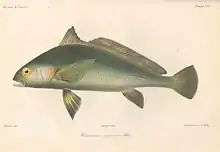| Pseudotolithus | |
|---|---|
 | |
| Pseudotolithus epipercus | |
| Scientific classification | |
| Domain: | Eukaryota |
| Kingdom: | Animalia |
| Phylum: | Chordata |
| Class: | Actinopterygii |
| Order: | Acanthuriformes |
| Family: | Sciaenidae |
| Genus: | Pseudotolithus Bleeker, 1863 |
| Type species | |
| Pseudotolithus typus Bleeker, 1863[1] | |
| Species | |
|
Several, see text | |
Pseudotolithus is a genus of marine ray-finned fish belonging to the family Sciaenidae, the drums or croakers. The species in this genus are found in the Eastern Atlantic Ocean.
Taxonomy
Pseudotolithus was first proposed as a genus in 1863 by the Dutch physician, herpetologist and ichthyologist Pieter Bleeker when he described the new species P. brachygnathus, P. epipercus and P. typus.[2] P. typus was designated as the type species by virtue of being named typus.[1] Ethelwynn Trewavas placed the eastern Atlantic Afrotropical sciaenids, Pseudotolithus and Pteroscion, in the tribe Pseudotolithini.[3] Other workers have placed this tribe in the subfamily Pseudotolithinae alongside the tribe Miracorvini, Miracorvina and Pentheroscion.[4] However, the 5th edition of Fishes of the World does not recognise tribes or subfamilies within the Sciaenidae which it places in the order Acanthuriformes.[5]
Etymology
Pseudotolithus prefixes Otolithus with pseudo meaning "false" due to Bleeker's perceived false resemblance between these fishes and those of that genus.[6]
Species
Pseudotolithus has the following valid species classified within it:[7]
- Pseudotolithus brachygnathus Bleeker, 1863[8]
- Pseudotolithus elongatus (Bowdich, 1825) (bobo croaker)
- Pseudotolithus epipercus (Bleeker, 1863) (Guinea croaker)
- Pseudotolithus moorii (Günther, 1865) (Cameroon croaker)
- Pseudotolithus senegalensis (Valenciennes, 1833) (cassava croaker)
- Pseudotolithus senegallus (Cuvier, 1830) (law croaker)
- Pseudotolithus typus (Bleeker, 1863) (longneck croaker)
Characteristics
Pseudotolithus croakers have a carrot-shaped swim bladder running the whole length of the body cavity with a pair of long tube-like appendages growing out of its front. These appendages branch into as many as 32 tubules. They do not have any barbels on the chin.[3] The largest species in the genus is the law croaker (P. senegallus) which has a maximum published total length of 230 cm (91 in) while the smallest is the bobo croaker (P. elongatus) at 47 cm (19 in).[7]
Distribution
Pseudotolithus croakers are found in the Western Atlantic Ocean from Morocco in the north to Angola in the south.[8]
References
- 1 2 Eschmeyer, William N.; Fricke, Ron & van der Laan, Richard (eds.). "Genera in the family Sciaenidae". Catalog of Fishes. California Academy of Sciences. Retrieved 4 July 2023.
- ↑ Bleeker, P. (1863). "Mémoire sur les poissons de la côte de Guinée". Natuurkundige Verhandelingen van de Hollandsche Maatschappij der Wetenschappen te Haarlem (Ser. 2) (in French). 18 (1862): 1–136.
- 1 2 A. R. Longhurst (1969). A synopsis of biological data on West African croakers (Pseudotolithus typus, P. senegalensis and P. elongatus) (PDF). Rome: Food and Agricultural Organization of the United Nations.
- ↑ Kunio Sasaki (1989). "Phylogeny of the family Sciaenidae, with notes on its Zoogeography (Teleostei, Peciformes)" (PDF). Memoirs of the Faculty of Fishes Hokkaido University. 36 (1–2): 1–137.
- ↑ J. S. Nelson; T. C. Grande; M. V. H. Wilson (2016). Fishes of the World (5th ed.). Wiley. pp. 497–502. ISBN 978-1-118-34233-6. Archived from the original on 2019-04-08. Retrieved 2023-07-05.
- ↑ Christopher Scharpf & Kenneth J. Lazara, eds. (9 March 2023). "Series Eupercaria (Incertae sedis): Families Callanthidae, Centrogenyidae, Dinopercidae, Emmelichthyidae, Malacanthidae, Monodactylidae, Moronidae, Parascorpididae, Sciaenidae and Sillagidae". The ETYFish Project Fish Name Etymology Database. Christopher Scharpf and Kenneth J. Lazara. Retrieved 5 July 2023.
- 1 2 Froese, Rainer and Pauly, Daniel, eds. (2023). Species of Pseudotolithus in FishBase. February 2023 version.
- 1 2 Eschmeyer, William N.; Fricke, Ron & van der Laan, Richard (eds.). "Species in the genus Pseudotolithus". Catalog of Fishes. California Academy of Sciences. Retrieved 4 July 2023.